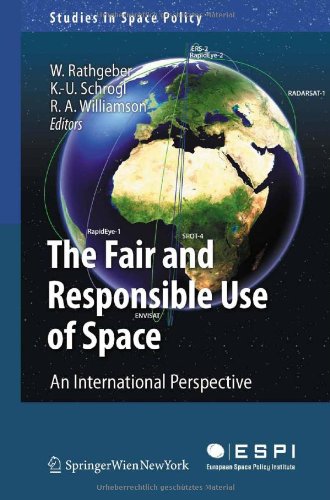| Book Name: | The Fair and Responsible Use of Space: An International Perspective |
| Category: | Aerospace Engineering |
| Free Download: | Available |
The Fair and Responsible Use of Space: An International Perspective

Table of contents :
Cover……Page 1
The Fair and Responsible Use of Space……Page 4
ISBN 9783211996522……Page 5
Preface……Page 6
Foreword by the Editors……Page 8
Table of Contents……Page 10
1.1 Definition of terms……Page 15
1.2 Fairness, justice and John Rawls……Page 16
1.3 The meaning of responsibility……Page 20
1.4 Similarities and differences……Page 21
1.5 Summary and application to the space arena……Page 22
2.1 Introduction……Page 25
2.3 Acceptance and promulgation of a set of best operational practices in space……Page 27
2.5 Space situational awareness (SSA)……Page 28
2.6 Space traffic management (STM)……Page 29
2.7 Banning debris-creating space weapons……Page 30
3 United Nations• space policy to preserve peace and sustainable development…….Page 33
3.1 Contributions of COPUOS relating to this topic……Page 35
3.2 Visions and personal opinion……Page 38
4 Current questions regarding fair and responsible use of space – summarising introduction…….Page 41
4.1.1. Introduction……Page 43
4.1.2. Space applications and the developing world……Page 44
4.1.2.1. Environmental security……Page 45
4.1.2.2. Space applications for disaster management……Page 46
4.1.2.3. Space and social development……Page 48
4.1.3.1. From prestige-driven space ageto information-driven space age……Page 49
4.1.3.2. Growth in number and diversity of actors……Page 50
4.1.3.4. Changing patterns of cooperation……Page 51
4.1.3.5. Rise of global utilities……Page 53
4.1.3.7. Growing interest in space explorationin a country marks transition from emergingto intermediate space power status……Page 54
4.1.4.1. Security on Earth underpinned by securityin space……Page 55
4.1.4.2. International cooperation as a meansto preserve space security……Page 56
4.1.5. What about space exploration?……Page 57
4.2.1. Introduction……Page 60
4.2.2. Military benefits……Page 61
4.2.3. Economic benefits……Page 63
4.2.4. Civil society benefits……Page 64
4.2.5. Costs to militaries of increasing militarisation/weaponisation……Page 66
4.2.6. Commercial costs of increased militarisation/weaponisation……Page 67
4.2.7. Costs to civil society of increasedmilitarisation/weaponisation……Page 70
4.2.8. Conclusions……Page 71
4.3.1. The situation in orbit……Page 74
4.3.2. Risks in orbit and on the ground……Page 77
4.3.3.1. Evaluation of the available solutions……Page 79
4.3.3.2. Prevention measures……Page 81
4.3.3.2.1. Principles of the measures……Page 82
4.3.3.2.2. Constraints……Page 83
4.3.3.3. Regulatory provisions……Page 84
4.3.4. Summary……Page 85
4.4.1. Introduction……Page 87
4.4.2.1. SSA in the United States……Page 88
4.4.2.2. SSA in Europe……Page 92
4.4.3. Defence, deterrence and SSA……Page 95
4.4.4. SSA as a dual strategic asset……Page 96
4.4.5. Reconciling different approachesin the international arena……Page 98
5 Fair rules on orbit – summarising introduction……Page 103
5.1.1. Terms and definitions……Page 106
5.1.2. The environment of data transfer……Page 107
5.1.3. Real-world examples……Page 108
5.1.4. Assessment and way ahead……Page 112
5.2.2. Space traffic through airspace……Page 115
5.2.3.1. Satellites……Page 117
5.2.3.2. Space communication networks……Page 118
5.2.3.3. Comparative table119……Page 119
5.2.3.4. Conclusion……Page 121
5.3 Current international space security initiatives……Page 123
5.3.1. Space security initiatives and international law……Page 124
5.3.2. Top-down initiatives……Page 125
5.3.2.1. The Chinese–Russian treaty proposal……Page 126
5.3.2.2. An “ICAO for space”……Page 127
5.3.3. Bottom-up initiatives……Page 128
5.3.3.1. The working group of experts on the long-termsustainability of space activities……Page 129
5.3.3.2. The European Union draft proposalfor an international code of conduct……Page 130
5.3.3.3. Satellite operator coordination initiative……Page 132
5.3.4. Concluding thoughts: the way forward……Page 133
5.4.1. What’s the problem……Page 136
5.4.2. Who are the major players?……Page 139
5.4.3. What is required?……Page 140
5.4.4. What are the issues?……Page 141
5.4.5.1. Government provider……Page 142
5.4.5.3. Non-profit company……Page 143
5.4.6. Moving forward……Page 144
5.5.1. The concept of “traffic” in outer space……Page 146
5.5.2. Elements of STM: findings from the 2006 study by the International Academy of Astronautics……Page 147
5.5.3. Research on STM following the IAA study……Page 150
5.5.4. STM as a new conceptual approach to regulating space activities……Page 151
5.5.5. STM and its relation to current policy activities……Page 153
5.5.6. STM as an approach to conceptualise equitable and fair use of outer space……Page 154
6 Achieving global engagement –summarising introduction……Page 157
6.1.2. The context……Page 160
6.1.2.1. Diversity increasesamongstakeholders in space……Page 161
6.1.3. Factors to influence cooperation……Page 162
6.1.4. The role of the United Nations……Page 163
6.1.5. The way forward……Page 164
6.1.5.3. Collaboration mechanisms……Page 165
6.1.5.5. Improvement of the institutional/legal framework……Page 166
6.1.6. Conclusion……Page 167
6.2.1. Introduction……Page 168
6.2.1.1. International organisation as the coreof “global governance”……Page 169
6.2.2. Power resources of international organisations……Page 170
6.2.3. Limitations of international organisations……Page 172
6.2.4.1. Leadership in international organisations……Page 173
6.2.4.2. Transfer of norms……Page 174
6.2.4.3. Moral obligations……Page 175
6.2.5.1. Norm entrepreneur……Page 176
6.2.6. Conclusion……Page 177
6.3.2. What is the space generation advisory council(SGAC)?……Page 179
6.3.3. The visions of the space generation advisorycouncil……Page 182
6.3.4. Safeguarding space……Page 185
6.3.5. Conclusions……Page 187
1. The “10 Steps to Achieve Fair and Responsible Use of Outer Space” as derived from the IAA/ESPI/SWF Conference on 20/21 November 2008 in Vienna……Page 189
2. Draft code of conduct for outer space activities……Page 192
2. Rationale……Page 199
4. Space debris mitigation guidelines……Page 200
5. Updates……Page 202
6. Reference……Page 203
About the authors……Page 205
List of acronyms……Page 215
List of figures and tables……Page 219
The Fair and Responsible Use of Space: An International Perspective
Author(s): Wolfgang Rathgeber, Kai-Uwe Schrogl, Ray A. Williamson
Series: Studies in Space Policy
Publisher: Springer, Year: 2010
ISBN: 9783211996522









![[PDF] Draw Buildings and Cities in 15 Minutes Draw Buildings and Cities in 15 Minutes pdf](https://www.freepdfbook.com/wp-content/uploads/2021/06/Draw-Buildings-and-Cities-in-15-Minutes-218x150.jpg)








![[PDF] Digital Image Processing An Algorithmic Introduction Using Java Digital Image Processing An Algorithmic Introduction Using Java](https://www.freepdfbook.com/wp-content/uploads/2022/06/Digital-Image-Processing-An-Algorithmic-Introduction-Using-Java.jpg)




![[PDF] 43 Years JEE ADVANCED + JEE MAIN Chapterwise & Topicwise Solved Papers 43 Years JEE ADVANCED (1978-2020) + JEE MAIN Chapterwise & Topicwise Solved Papers Physics PDF](https://www.freepdfbook.com/wp-content/uploads/2022/03/43-Years-JEE-ADVANCED-1978-2020.jpg)

![[PDF] Problems in Physical Chemistry for JEE (Main & Advanced) Problems in Physical Chemistry for JEE (Main & Advanced) Free PDF Book Download](https://www.freepdfbook.com/wp-content/uploads/2022/03/Problems-in-Physical-Chemistry-for-JEE-Main-Advanced.jpg)
![[PDF] Engineering Physics (McGraw Hill)](https://www.freepdfbook.com/wp-content/uploads/2021/05/bafc8c2685bb6823a9c56134f7fba5df.jpeg)

![[PDF] Engineering Chemistry By Shashi Chawla](https://www.freepdfbook.com/wp-content/uploads/2022/05/Theory-And-Practicals-of-Engineering-Chemistry-By-Shashi-Chawla-free-pdf-book.jpeg)
![[PDF] Chemistry: An Introduction to Organic, Inorganic & Physical Chemistry Chemistry: An Introduction to Organic, Inorganic & Physical Chemistry](https://www.freepdfbook.com/wp-content/uploads/2022/04/Chemistry-An-Introduction-to-Organic-Inorganic-Physical-Chemistry.jpg)
![[PDF] Essentials of Physical Chemistry Essentials of Physical Chemistry Free PDF Book by Bahl](https://www.freepdfbook.com/wp-content/uploads/2022/04/Essentials-of-Physical-Chemistry-bahl.jpg)
![[PDF] Biological control of plant-parasitic nematodes: soil ecosystem management in sustainable agriculture Biological control of plant-parasitic nematodes: soil ecosystem management in sustainable agriculture](https://www.freepdfbook.com/wp-content/uploads/2022/05/Biological-control-of-plant-parasitic-nematodes-soil-ecosystem-management-in-sustainable-agriculture.jpg)
![[PDF] Human Anatomy: Color Atlas and Textbook Human Anatomy: Color Atlas and Textbook Free PDF Book](https://www.freepdfbook.com/wp-content/uploads/2022/05/Human-Anatomy-Color-Atlas-and-Textbook.jpg)
![[PDF] Concepts of Biology Book [Free Download]](https://www.freepdfbook.com/wp-content/uploads/2022/05/Concepts-of-Biology.jpg)
![[PDF] Essentials of Biology [Free Download] Essentials of Biology Free PDF BOok Download](https://www.freepdfbook.com/wp-content/uploads/2022/05/Essentials-of-Biology-Free-PDF-Book-Downlaod.jpg)
![[PDF] Human Biology Book [Free Download]](https://www.freepdfbook.com/wp-content/uploads/2022/05/PDF-Human-Biology-Book-Free-Download.jpg)


